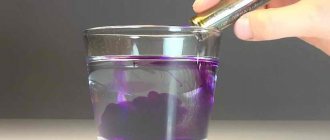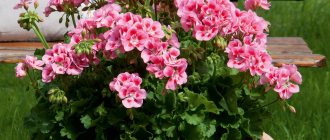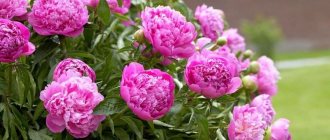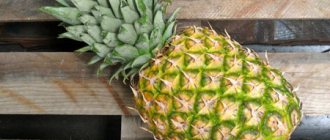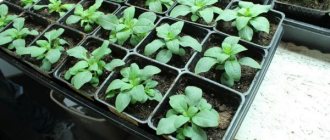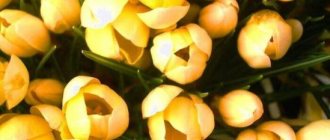Author of the article
Daria Vorontsova
Reading time: 14 minutes
AA
How to grow beautiful fragrant lavender at home? You just need to follow some rules. Which one? Read our article!
Beautiful and spectacular lavender attracts not only its amazing aroma, but also the unusual combination of simplicity and brightness of the inflorescences. It looks equally attractive both in open ground and in bouquets. Those who want to enjoy the delicate aroma of the plant all year round can try growing it at home. But do not forget that this is a rather capricious plant, demanding on conditions. Therefore, you will have to put in a lot of effort before neat bushes with purple inflorescences will delight your eye.
Can it be grown?
Due to the fact that lavender is a heat-loving shrub, it is possible to grow it at home in a pot, but provided that the plant receives enough sunlight and water, and the room is warm and there are no drafts.
This is what lavender looks like and blooms in a pot:
Suitable species and varieties
Not all varieties of lavender are suitable for planting at home. The culture must be heat-loving in order to feel comfortable at room temperature.
There are more than 30 types of lavender, but the most popular are three varieties :
- narrow-leaved (English);
- broadleaf (French);
- hybrid (Dutch).
The first two types are most suitable for planting in a pot. They usually bloom from May (June) to August.
The most suitable crops for growing at home are the following varieties:
- Sweet;
- Munstead;
- Dwarf Blue;
- Peter Pan;
- Silver Blue;
- Sharon Roberts;
- Lavender Lady.
If you follow the growing rules, these varieties adapt perfectly to indoor conditions , delighting their owners with beautiful flowering and delicate aroma.
Variety of indoor lavender
Thanks to the indoor format, it is not at all necessary to limit yourself to only the most popular garden plant and the most frost-resistant type of “English” lavender - angustifolia lavender (Lavandula angustifolia). Its large, up to 40 cm in height in pots, wide and dense bushes are compact in indoor format, and the classic apical spikelets of inflorescences are stunningly fragrant.
The choice of varieties with white, blue, pink and all shades of purple is very large (the color is usually reflected in the name of the variety - Alba, Hidcote Blue, Rosea, etc.). But other types of lavender can be grown in rooms.
Broadleaf lavender (Lavandula latifolia), also known as French or butterfly lavender, is famous not so much for its brighter and larger leaves, but for the very beautiful shape of its larger flowers with long bracts. The flowers bloom on tall peduncles, as if floating above the greenery. Although not as fragrant, this lavender looks more exotic and vibrant. Its varieties are predominantly pink-purple.
Most indoor lavenders are hybrid unnamed varieties, which are selected based on the color of the inflorescences. Among them there are also varieties belonging to the so-called hybrid, transitional, or Dutch lavender (Lavandula x intermedia), famous for its spectacular flowering.
They are easily recognized by their larger and spreading bushes. The leaves of almost all varieties are silvery, and the flowers are larger, in long, spectacular spikelets. In varieties you can choose shades of blue, lilac and violet colors.
The necessary conditions
Growing live lavender at home is not an entirely simple task, since you need to comply with a number of requirements for the plant to feel comfortable, actively develop and bloom.
The soil
To begin with, the crop must be provided with suitable soil .
In nature, lavender grows on alkaline soils with a predominance of sand. Therefore, it is necessary to add coarse river sand to the soil mixture for the pot.
In general, the plant requires loose, light, alkaline and breathable soil . Acidic soil is not suitable for growing. You can buy the finished mixture in the store, or you can prepare it yourself from:
- sand;
- humus;
- turf or leaf soil.
All components will need to be mixed in a ratio of 1:1:2 . Before a crop is planted or sown in the soil, it will need to be sifted to remove debris and large lumps, and then disinfected with potassium permanganate.
To make the soil loose and breathable, you should add a little fine crushed stone to it.
Potty
One of the important attributes for growing lavender at home is a pot.
It should be wide and deep enough, since the plant has a deeply penetrating, tap root system that needs space to develop.
The minimum depth of the container should be 12-14 cm , the minimum diameter should be 30 cm, and the volume should be at least 2 liters. The pots can be any shape (rectangular, square or round).
It is advisable that the container be made of ceramic or clay.
If the container is selected for sowing seeds, then it must have sides at least 7 cm high . In the future, the lavender will need to be replanted and you will need to take a container approximately 7 cm larger in size.
The larger and more spacious the pot, the more opportunity the plant has to grow and develop.
To grow lavender outdoors, you need to select pots made from weather-resistant materials. For example, containers made from :
- ceramics;
- concrete;
- clay;
- gypsum
If metal flowerpots are used, they must be enameled or stainless. Wooden containers must have a waterproof coating.
In what places does it grow?
Lavender in a pot can be grown in three places:
on the windowsill;- on the balcony (loggia);
- on the street.
If the plant will grow indoors, then you should choose windows located on the south or southwest side - in this case, the crop will receive enough light and heat.
But in winter, lavender bushes, even on a southern windowsill, will lack sunlight , so at this time they will need additional illumination with a fluorescent or phyto lamp.
The bush should be in the light:
- in winter about 7 hours a day;
- in summer - at least 12 hours.
also important to regularly ventilate the room so that the plant receives a sufficient amount of oxygen , but this should not create a draft.
As for temperature, these indicators are different for each variety. But, as a rule, lavender does not tolerate temperature drops from +5 ̊C. During active growth and development, especially in summer, it prefers moderate temperatures from +18 to + 20 ̊C. She doesn't like heat. To ensure optimal performance in summer, it is worth humidifying the air in the room or taking the plant out into the fresh air.
As a rule, the plant is taken out to the balcony or street in the summer . At the first return frost, it is better to bring it into the house or leave it on a glazed balcony (loggia), covering the bush with spruce branches.
When growing potted lavender outdoors, it is also important to choose a sunny and warm place, since the crop does not grow well in the shade.
How to make a pot with your own hands
Thrifty owners will consider it irrational to buy a new lavender pot every year, because you can make it yourself from simple materials.
Wicker pot
Available materials
To make a pot with your own hands, you can use simple and affordable materials:
- Gypsum;
- Concrete;
- Wooden;
- Brushwood;
- Vine;
- Clay.
Note! For some reason, most people forget about old jars, buckets and plastic containers; using them, you can make a new flowerpot and decorate it to your taste.
List of components
Depending on the selected material, additional components will be required:
- Quick fix adhesive;
- Concrete, plaster and clay will need water;
- Varnish coating to protect wood from moisture;
- Wicker pots require a plastic base, strong twine and burlap.
Which planting method is better to choose?
There are several ways to plant lavender:
- seeds;
- cuttings;
- layering;
- seedlings.
Each of these methods has its own characteristics, pros and cons.
Cuttings
The essence of this method is to separate shoots from an already mature bush and make cuttings from them, which will later be planted in the ground. To implement this planting technology it is necessary :
- Cut annual shoots from an adult bush.
- Divide them into small pieces, 10 cm long.
- Cut off the lower part (it will take root) at an angle of 45 degrees and treat it with a root formation stimulator.
- Plant the cuttings in a mixture of sand and peat (1:1 ratio), cover with film and leave until rooted.
- After the roots appear, prepare containers: take pots (preferably clay), with a diameter of 25-30 cm, and place drainage on their bottom (nut shells, sawdust, small shards or pebbles are suitable).
- Prepare the soil: mix leaf soil, humus and sand with a small amount of lime in a ratio of 3:2:1.
- Pour the soil mixture into the pots.
- Plant rooted cuttings.
The advantage of this method is:
- its simplicity;
- no need for special knowledge or experience;
- seedling survival rate and flowering rate (the next year after planting).
However, the disadvantage of this method is that to obtain a cutting you need an adult plant.
Seeds
To grow lavender this way, you will need:
container for sowing;- pots for replanting;
- lavender seeds;
- mulch;
- drainage;
- spray.
To begin with, the seeds must be stratified to increase seed germination. They are usually stratified in the refrigerator. To do this you need :
- Take non-woven napkins or cotton pads.
- Place the disk (or napkin) on the bottom of a container with a lid.
- Sprinkle the seeds onto it, covering with a second disk.
- Add a little water and drain off excess liquid.
- Leave the container for 2-3 days in a warm place for the seeds to swell, and then put it in the refrigerator.
The first shoots will appear in about a month. They can be planted when about a quarter of all seeds have sprouted. To do this, you need to prepare containers and soil, and then start sowing seeds :
- The container must be filled with soil mixture and leveled.
- Moisten the soil with a spray bottle.
- Plant the seeds to a depth of approximately 3 mm, at a distance of 1.5-2 cm from each other.
- Lightly sprinkle with soil.
- Cover the container with a lid or film.
- Place the container in a well-lit, warm place.
Seedlings need to be provided with light moisture by periodically spraying the soil . If all conditions are met, the first shoots will appear in a couple of weeks. In this case, the film will need to be removed and the containers moved to the brightest place.
When the seedlings have 3-4 true leaves, they will need to be picked.
Plants must be replanted very carefully so as not to damage the root system.
The advantage of this method is the ability to grow a plant from the very beginning, knowing exactly its variety, how the seedlings were grown and how they were treated (when purchasing ready-made planting material, there is no such certainty). However, this is the most labor-intensive and time-consuming method (you will have to wait 2 years before the first flowering) of growing lavender, the end result of which will not always be successful.
Seedlings
Typically, this method is used if the lavender was purchased in a store ready-made, that is, in the form of seedlings.
Also, the technology of planting seedlings in this way is suitable if the lavender was grown from seeds. As a rule, such bushes are small in size, so you must first select small pots for them , 3-4 cm larger than the earthen ball.
To plant lavender using this method, you need:
- Pour drainage (gravel or expanded clay) into the bottom of the selected container, carefully placing it so as to leave the holes open. Then the watering water will not accumulate in the pot, and there will be air from below.
- Pour soil into the container.
- Make a hole and water it.
- Plant the bush in the hole and sprinkle it with soil mixture.
- Water with growth stimulator Zircon.
This method is distinguished by its simplicity (especially if the seedlings were purchased and not grown independently) and quick results (the plant will soon take root and will delight in flowering).
By layering
Cuttings are the outermost shoots of a lavender bush that were intentionally rooted into the ground. The planting technology in this way is as follows :
- In March or April, the shoot must be bent to the ground and secured with a wooden or metal slingshot.
- Sprinkle the area in contact with the ground and moisten.
- At this time, roots begin to form on the layering. The rooted area is separated from the mother bush after about 2 months.
The advantage of this method is reliability, low labor intensity and good results.
The simplest planting methods are to grow lavender using cuttings or seedlings (if it was purchased in a store) - they do not require special knowledge, time and effort, but you can get the first flowers the next year.
Kinds
Today there are many varieties of lavender, each of which has certain characteristics.
English
This plant is native to southern Europe. It is a perennial shrub characterized by small lilac inflorescences and silvery foliage. The crop blooms in July-August. It is very resistant to frost. The most common type of lavender is the dolphin-shaped plant. It does not exceed 30 centimeters in height and has attractive silvery foliage. The Hidcoat variety is very popular. It is used to decorate small hedges.
Common varieties of English lavender include the following:
- Hidcoat Giant - has a compact size and reaches 60 centimeters;
- Alba - the plant grows 50 centimeters and has white inflorescences;
- Manstead - the bush grows up to 40 centimeters and is distinguished by rich blue flowers;
- Rosea - the culture reaches 40 centimeters and has a purple tint;
- Hidcoat Blue - grows up to 40 centimeters and has purple flowers.
French
This lavender is also called broadleaf lavender. It has an intense aroma and attractive flowers. They come in pink, white, lilac. There are purple and burgundy tones. The culture begins flowering in April-May and ends in July. The plant may bloom again in August.
French culture can hardly be called frost-resistant. Therefore, it is recommended to grow it in warm regions. The most popular plant species is Lavandula stoechas pedunculata. The culture is characterized by original inflorescences.
The following varieties are the most popular in this category:
- Rocky Road - is a new variety characterized by purple inflorescences;
- Yellow Vale - it is characterized by rich purple inflorescences and yellowish foliage;
- Tiara - has large blue flowers and cream bracts;
- Regal Splendur - has flowers of rich purple color;
- Helmsdale - distinguished by its lilac color with a burgundy tint.
Hybrid
This lavender is also called Dutch lavender. This category includes highly decorative hybrids. They are massive bushes. They are characterized by large flowers. The plant has narrow leaves. They have a beautiful silver color. Lavender blooms in July.
Well-known varieties in this category include the following:
- Arabian Knight - distinguished by bright purple flowers;
- Alba – has a white color;
- Richard Gray - is a small bush with purple flowers;
- Grosso - lavender is characterized by purple flowers;
- Sawyers - has a soft lilac color.
Serrated
This is a special variety of plant that is distinguished by silvery foliage. It is characterized by large flowers of different shades of purple. This crop is more suitable for indoor growing. It is not recommended to plant it in open soil.
Narrow-leaved
This is an unpretentious plant that tolerates low temperatures well. The shrub begins to bloom in mid-summer. A characteristic feature of the culture is its narrow leaves. They have a grayish color. The bush has a compact size.
Transfer
Lavender requires systematic transplanting from one pot to another - in this case, the root system will fully grow and not rest against the bottom of the container.
When should it be carried out?
It is recommended to carry out the procedure every year until active growth begins.
However, the option of replanting is possible at any time (even during the flowering period) , if the crop is provided with proper care, high air humidity and moderate temperature.
Transplantation is necessary to rejuvenate the plant and increase its growth rate.
You can understand that lavender needs to be planted in a larger pot by the appearance of the bush - a large number of new shoots can be seen near the edge of the container, and the lavender has slowed down its development and growth.
What kind of soil and container is needed?
When replanting a bush, choosing a suitable pot, you need to start from the size of the root system . The new container should be 5-7 cm larger than the previous one, and the roots should not reach the walls of the container. This will allow the powerful lavender roots to develop normally.
The minimum diameter of the pot is 30 cm and the volume is 2 liters. The depth should be such that the rhizomes can develop freely until next year. The depth must be greater than the diameter of the container. Also, do not forget that lavender grows better not in plastic containers, but in natural ones (ceramic, clay). The holes for water in them should be either frequent or large.
As for the soil, the plant should still choose light, non-acidic alkaline soil. It is recommended to prepare your own soil mixture consisting of :
- universal flower soil;
- a small amount of lime or wood ash (1-2 tsp);
- sand;
- peat
Technology
To transplant lavender to a new place, you will need:
- Suitable size pot.
- Drainage (expanded clay).
- Soil mixture.
- Growth stimulator Zircon (for watering after transplantation).
First you need to prepare the pot:
- Make drainage: pour expanded clay onto the bottom of the pot in a layer of 2-4 cm.
- Fill in some of the soil mixture and make a hole corresponding in size to the diameter and depth of the previous lavender pot.
Then the transplant itself is carried out, for this you need:
- Remove the lavender from the old pot. It will come out easier if you turn it upside down and spill the soil with water before doing so.
- Plant the bush in the prepared hole so that the surface of the soil of the previous pot is not covered with new soil.
- Sprinkle with prepared soil mixture.
At the end you need to water the planted bush, for this you will need:
- Dilute the growth stimulator Zircon (take 10 ml of the product per 5 liters of water at room temperature).
- It is good to spill the soil around the edges of the pot.
- When the water has drained, fill the voids that appear with soil and lightly compact them.
The many-faced beauty lavender is at your service
Today there are over 30 varieties of lavender. In gardening, only a few names are used. Let's get acquainted with the most popular varieties.
Narrow-leaved (English)
The plant is an erect, branched bush with an extensive root system. Its height reaches up to 1 m. With active development, it forms a lush crown of many shoots.
Popular subspecies:
- "Alba";
- "Sentiva Blue";
- "Munstead."
Its leaf blades are oblong and dark green. The edges are smooth. The maximum length of the buds is about 1 cm. The racemose inflorescences have a rich purple hue. English lavender can withstand frosts down to 20°C. Lives in one area for up to 20 years.
Broadleaf (French) lavender
The flower grows up to 1.5 m in height. Leaf blades of rich green color are located along an erect stem. Light purple buds are crowned with stable flower stalks. They emit a pleasant aroma. They bloom in mid-April and bloom until early summer. Under favorable conditions, flowering repeats in September. French lavender easily tolerates drought and does not lose its attractiveness at a temperature of +16°C.
Jagged Lavender
The fragrant beauty of this species is distinguished by its high growth, up to 150 cm. It received its name due to the jagged edges of the leaf plates. Known varieties:
- "Royal Grown" (purple);
- "Redundulata" (pale pink);
- "Regal Splendour" (lilac).
Spike-shaped inflorescences contain up to 10-12 buds, which are colored bright purple. The variety is considered heat-loving. The first signs of the disease appear already at a temperature of +15°C.
Hybrid (Dutch) lavender
The variety is bred from narrow-leaved and broad-leaved species. Under favorable conditions it grows up to 2 m in height. The inflorescences bloom in the first month of summer. It is used as an industrial raw material for the production of essential oils and medicinal herbs.
Rules of care
In order for lavender to grow, develop and bloom well, it is necessary to provide it with the following care:
Loosening the soil . To ensure aeration, it is necessary to loosen the soil weekly.- Watering. Water the plant with soft, settled water. In the first couple of months after planting, watering is carried out 2-3 times a week, after which moisture is carried out as the soil dries.
Any water that has leaked out of the drainage holes must be removed immediately to prevent it from being absorbed back. To retain moisture longer, it is worth covering the soil surface with a layer of mulch made from sawdust or pine needles.
- Feeding . To improve the growth of green mass of bushes, it is necessary to apply nitrogen fertilizers twice a year. Also, during the flowering period, complex fertilizing is applied.
- Trimming . It is necessary not only for maintaining the decorative appearance of lavender, but also for better growth of healthy, young shoots. For this purpose, it is necessary to trim damaged and dry branches. The first procedure is carried out immediately after flowering has completed (the top of the bush needs to be slightly trimmed), the second - at the end of autumn (the shoots should be shortened by 1/3 and the bush should be slightly thinned, leaving a few green stems).
- Lighting . Lavender needs a lot of sunlight - for this reason it should be placed in a south or south-east window. If there is not enough natural light, it must be compensated by artificial lighting with a fluorescent lamp.
Lavender pruning
Pruning is considered one of the most important components of care, and not only the decorative effect, but also the existence of the plant depends on the correctness of its behavior.
Trimming methods
The plant needs constant pruning. This helps maintain decorativeness for many years and maintain the compact shape of the bush.
Trimming to shape
This type of pruning can be called radical, because the shoots can be shortened by 1/3 or even ½. Most often, such pruning is resorted to after a few minutes of frost, or immediately after spring planting of young plants. The bush is pruned down to woody branches to give it a certain shape.
Attention! In radical pruning, shoots are cut down to the level of lignified wood, leaving a small, non-lignified growth of the current year. If pruned excessively, the bush may not grow back.
Pruning to stimulate flowering
It is recommended to carry out this type of pruning immediately after flowering, without waiting for complete flowering. It is advisable that most of the flowers in the inflorescence have already faded, but some blooming ones remain. The plant begins to grow new shoots that bloom again.
Advice! In northern regions, where the plant will not have time to bloom again, it is recommended to postpone pruning until spring, since young shoots may not have enough time to form, which will lead to freezing in winter.
Rejuvenation of bare bushes
Lavender cannot be pruned to its stump like many other shrubs. Such pruning will certainly lead to the death of the plant. Therefore, rejuvenation of bushes that have lost their appearance is carried out in several stages. In the first year, one half of the bush is radically pruned, and the next year the second. This technique will preserve the plant and get rid of bare branches.
Pruning for winter
Autumn pruning is carried out in early autumn after the second flowering. The shoots are cut short, leaving 2-3 cm of young wood. In this state, the bush is easier to cover for the winter. It is also worth trimming shoots that are too long, which can be damaged by wind or snow.
How to protect a flower from pests and diseases?
As a rule, at home, lavender is less susceptible to various diseases and pest invasions. She usually suffers from improper care. However, there are still some diseases and insects that can harm lavender bushes:
- Gray rot . It has the appearance of a white fluffy coating that appears on the shoots. Over time, small pockets grow and turn into gray-blue mold - during this period the death of the plant begins. At the initial stage of disease development, it will be necessary to spray the crop with copper sulfate or Hom. In later stages, medications will not help much.
- Powdery mildew . It appears as a white coating, which over time becomes covered with white droplets. With the formation of spores, the spots turn brown, and then a coating appears on the shoots and buds. To combat the disease at the initial stage, it is necessary to provide the lavender with better lighting and avoid waterlogging of the soil. Among the drugs that will help are Fitosporin, Baktofit, Alirin.
- Spider mite . They enter the house through an open window or shoes. A sign of their appearance is a light cobweb on the shoots. To get rid of mites, you need to treat the plant with Fitoverm.
In order to prevent the occurrence of diseases, it is necessary to ensure that the plant receives enough sunlight and that the soil is not over-moistened (or over-dried). It is recommended to fertilize to maintain and strengthen the immunity of lavender.
Photo gallery
Photos of different varieties of lavender
Lavender Heathcote
Lavender Sweet
Lavender Sharon Roberts
Lavender Snow man
Lavender Nana Alba
Lavender Munstead
Possible difficulties
In general, growing lavender bushes at home is not difficult or problematic . However, there are some nuances that you should know about before planting a plant in your home.
At home
The main difficulty in growing lavender at home is that it is a “wild” plant that is not sufficiently adapted to growth and development in the limited space of a pot. Other difficulties and nuances are:
Always provide the plant with a spacious container - since lavender has a long central root, which should not rest against the bottom of the pot (otherwise it will stop growing).
Therefore, it is necessary to transplant it annually into deeper and freer containers.At the same time, the plant itself does not like to be constantly disturbed, so it tolerates transplants with difficulty. To reduce stress levels, the procedure must be carried out very carefully and during the bush’s dormant period.
- The need to provide the crop with an influx of fresh air - if the room is not ventilated regularly, it will begin to “suffocate” and stop growing.
- The need to monitor the maintenance of optimal humidity levels, since lavender does not tolerate waterlogging. It also does not respond well to soil drying out.
- Providing the required amount of light - in winter and cloudy days it is necessary to install additional lighting for the crop with a fluorescent lamp.
On the balcony and on the street
If the plant is exposed to fresh air in summer and spring (whether on a balcony or street), it is important that the lavender is not in the shade. Otherwise, its cultivation will become practically useless: the bush will develop poorly and will not bloom.
The main difficulty lies in wintering the crop . You should not leave the plant on open balconies (or in the garden) in frosty winters - there is a high probability that it will die. At +5 ̊C, lavender goes into a dormant state, so it is worth bringing it into the house at this time. Another option for wintering is to leave the crop on a glazed and unheated balcony (or loggia).
As with growing in an apartment or open ground, lavender in a pot on a balcony or street requires timely pruning, which should not be forgotten.
The main mistakes of novice flower growers
Despite the abundance of various instructions and tips, many new flower growers make common mistakes.
- Wrong choice of pot. A common misconception is that if a plant is small, it does not need a large container. This is not true. Lavender loves space, and it needs a lot of space for proper development of the root system.
- Violation of the light regime. For many, the knowledge that lavender does not tolerate heat well sounds like an alarm and caring owners hide the bushes from the sun in partial shade, forgetting that lavender does not like this either.
- In search of light in winter, the plant is placed on the brightest windowsill, where the temperature does not rise above 15°C.
- Afraid of overwatering the plant, beginners often dry it out. Drying out the soil has the same detrimental effect on the plant as too much water.
Advantages and disadvantages
The main advantages of growing lavender at home in a pot include:
Less susceptibility of the plant to various diseases and pests.- A pleasant aroma wafting throughout the house.
- Always have lavender at hand: for carrying out procedures or cutting branches (in a sachet, for taking a bath or creating a fragrant pad).
However, this option for growing lavender bushes also has a number of disadvantages:
- Easier to care for than when planted in open ground.
- Individual intolerance to the smell of lavender.
- The need for annual transplantation.
User reviews
The generalized pros and cons of growing were presented above, while gardeners on forums share more specific advantages and disadvantages of planting lavender at home.
So, they consider the advantages:
- Pleasant, calming aroma (if you place lavender in the bedroom, it helps improve sleep).
- Decorativeness of the bush.
- A wide range of uses: in cooking (as an additive to tea), in folk medicine (essential oil helps relieve pain from a burn, accelerates healing), in everyday life (put cut dried twigs in a closet to ward off moths).
And gardeners consider it a disadvantage:
- Difficult to grow from seeds.
- The need to ensure optimal conditions of detention (if any point is not met, the lavender dies).
The opinions of flower growers can be found here, here, on this forum, on the website and this resource.
Should the pot be reused?
When the previous shrub is transplanted to a new location, there is no need to rush to dispose of the old pot; it can be reused.
How to clean
The pot can be used again to plant a new lavender bush. Before use, it is necessary to remove any remaining potting soil and plaque on the walls. How to do this:
- The vessel is washed, large pieces of plaque are removed with a metal sponge or brush;
- The container is soaked for 40 minutes. in water mixed with 9% vinegar in a ratio of 3:1. The solution can be poured into the middle of the pot if there are no holes in it;
- After the plaque becomes soft, it can be easily removed with a brush or washcloth.
Note! Detergents and cleaners can be used, but they are absorbed into porous materials. The washed vessel should be soaked in water for at least 12 hours before use.
How to fix
A common problem with clay and ceramic pots is the appearance of cracks, but there is no need to rush to throw them away. If the flowerpot is cracked but holds its shape, the crack can be covered with clay or filled with sealing glue or silicone.
If the pot has split into several large pieces, it can be glued together using cyanoacrylate glue and sealing compounds. Taped seams look unattractive; the repaired item can be decorated to your taste.
Lavender in a pot at home is beautiful and unusual; it will bloom and fill the air with a subtle aroma. Anyone can grow it if they choose the right place and follow the planting rules.


